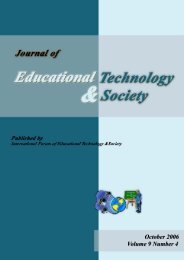Student Engagement: What do we know and what should we do?
Student Engagement: What do we know and what should we do?
Student Engagement: What do we know and what should we do?
Create successful ePaper yourself
Turn your PDF publications into a flip-book with our unique Google optimized e-Paper software.
learning became popular in the 1980’s <strong>and</strong> 1990’s as a way to make content more<br />
accessible to students struggling with traditional text-<strong>and</strong>-talk pedagogies. Ho<strong>we</strong>ver,<br />
more recently the construct of student engagement is ubiquitously incorporated into<br />
district plans <strong>and</strong> classrooms with the hopeful intention of enhancing all students’<br />
abilities to learn how to learn or to become lifelong learners in a “Knowledge-based<br />
society” (Gilbert, 2007, p. 1). Today, it is fair to say that student engagement has become<br />
both a strategic process for learning <strong>and</strong> an accountability goal or outcome unto itself.<br />
Across Canada, as <strong>we</strong>ll as internationally, student engagement has become one of the key<br />
concerns <strong>and</strong> key strategies for educational <strong>and</strong> social reform particularly in middle <strong>and</strong><br />
high schools. (For example, see Dunleavy, 2008, p. 23; Dunleavy & Milton, 2009, p. 4;<br />
Harris, 2008, p. 57; Willms, Friesen & Milton, 2009, p. 5). School boards, administrators,<br />
<strong>and</strong> teachers seemingly embrace student engagement as the next step to secondary school<br />
improvement. There is a sense of hope throughout the literature that educators <strong>and</strong><br />
teachers can bring about positive change <strong>and</strong> increase student engagement in learning.<br />
The National Research Council (2003) affirms that schools can have a positive <strong>and</strong><br />
meaningful impact on student engagement <strong>and</strong> student achievement.<br />
Five core types of student engagement are most frequently noted in current literature: (1)<br />
Academic, (2) Cognitive, (3) Behavioral, (4) Psychological, <strong>and</strong> (5) Social; ho<strong>we</strong>ver,<br />
many more categories or variations are added each year. Academic engagement is most<br />
often measured in levels of academic achievement. Canada has historically been quite<br />
strong in ratings of academic achievement according to PISA results (Stats Canada, 2003<br />
& 2006). According to Willms’ (2003) review of PISA 2000 results on <strong>Student</strong><br />
<strong>Engagement</strong> at School: A Sense of Belonging <strong>and</strong> Participation, Canada also sho<strong>we</strong>d<br />
moderate success in Participation <strong>Engagement</strong> levels (74%) <strong>and</strong> fared <strong>we</strong>ll in Sense of<br />
Belonging (80%) categories in the year 2000.<br />
Ho<strong>we</strong>ver, in just over ten years, educators have become alarmed at increasingly “high<br />
levels of student disengagement, evidenced by early school leaving, poor student<br />
behavior, <strong>and</strong> low levels of academic achievement” (Harris, 2008, p. 1). More recent<br />
research by Willms, Friesen & Milton (2009) suggests that now “less than one-half of<br />
Canadian students are deeply engaged in their study of school subjects” (p. 17).<br />
Meanwhile, the Conference Board of Canada is alarmed <strong>and</strong> concerned that, as Canada<br />
faces a demographically induced critical shortage of skilled workers, many graduating<br />
students <strong>do</strong>n’t seem to have the learning, adaptive, technical, critical thinking, <strong>and</strong><br />
relational skills they need to “pursue performativity” (Gilbert, 2007). It is evident that<br />
more jobs will require post-secondary level skills; ho<strong>we</strong>ver, Gilbert further urges that<br />
students today need not only core literacies <strong>and</strong> foundations of <strong>know</strong>ledge, but also need<br />
to “take elements from one <strong>know</strong>ledge system <strong>and</strong> put them together with elements from<br />
another, different <strong>know</strong>ledge system, re-arranging them to <strong>do</strong> something new <strong>and</strong><br />
different” (Gilbert, 2007, p. 8).<br />
This interdisciplinary, meta-cognitive, <strong>and</strong> constructive learning skill set appears to be<br />
lacking in our past <strong>and</strong> perhaps current curriculum <strong>and</strong> pedagogy. Sir Ken Robinson<br />
(2009) agrees but states, “no other period in human history could match the present one<br />
<strong>Student</strong> <strong>Engagement</strong>: <strong>What</strong> <strong>do</strong> <strong>we</strong> <strong>know</strong> <strong>and</strong> <strong>what</strong> <strong>should</strong> <strong>we</strong> <strong>do</strong>? 7












